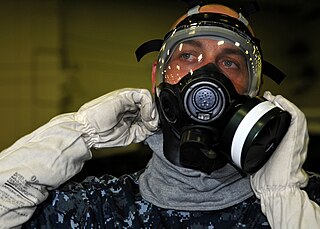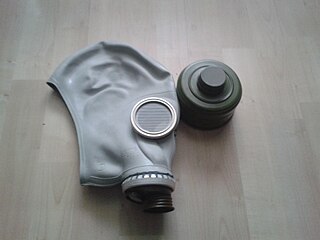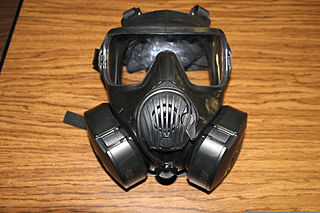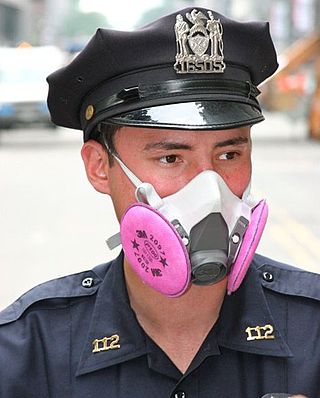
A gas mask is an item of personal protective equipment used to protect the wearer from inhaling airborne pollutants and toxic gases. The mask forms a sealed cover over the nose and mouth, but may also cover the eyes and other vulnerable soft tissues of the face. Most gas masks are also respirators, though the word gas mask is often used to refer to military equipment, the scope used in this article. The gas mask only protects the user from digesting, inhaling, and contact through the eyes. Most combined gas mask filters will last around 8 hours in a biological or chemical situation. Filters against specific chemical agents can last up to 20 hours.

Personal protective equipment (PPE) is protective clothing, helmets, goggles, or other garments or equipment designed to protect the wearer's body from injury or infection. The hazards addressed by protective equipment include physical, electrical, heat, chemical, biohazards, and airborne particulate matter. Protective equipment may be worn for job-related occupational safety and health purposes, as well as for sports and other recreational activities. Protective clothing is applied to traditional categories of clothing, and protective gear applies to items such as pads, guards, shields, or masks, and others. PPE suits can be similar in appearance to a cleanroom suit.

Aberdeen Proving Ground (APG) is a U.S. Army facility located adjacent to Aberdeen, Harford County, Maryland, United States. More than 7,500 civilians and 5,000 military personnel work at APG. There are 11 major commands among the tenant units, including:

The use of toxic chemicals as weapons dates back thousands of years, but the first large-scale use of chemical weapons was during World War I. They were primarily used to demoralize, injure, and kill entrenched defenders, against whom the indiscriminate and generally very slow-moving or static nature of gas clouds would be most effective. The types of weapons employed ranged from disabling chemicals, such as tear gas, to lethal agents like phosgene, chlorine, and mustard gas. This chemical warfare was a major component of the first global war and first total war of the 20th century. The killing capacity of gas was limited, with about 90,000 fatalities from a total of 1.3 million casualties caused by gas attacks. Gas was unlike most other weapons of the period because it was possible to develop countermeasures, such as gas masks. In the later stages of the war, as the use of gas increased, its overall effectiveness diminished. The widespread use of these agents of chemical warfare, and wartime advances in the composition of high explosives, gave rise to an occasionally expressed view of World War I as "the chemist's war" and also the era where weapons of mass destruction were created.

The Expert Field Medical Badge (EFMB) is a United States Army special skills badge first created on June 18, 1965. This badge is the non-combat equivalent of the Combat Medical Badge (CMB) and is awarded to U.S. military personnel and North Atlantic Treaty Organization (NATO) military personnel who successfully complete a set of qualification tests, including both written and performance portions. The EFMB is known for its adherence to its testing standards and, as such, requires strict attention to detail from candidates in order to receive a "GO" on its combat testing lanes. The pass rate for FY 2017 was 7%, making the EFMB one of the most difficult and prestigious Army special skill badges to earn.

A respirator is a device designed to protect the wearer from inhaling hazardous atmospheres including fumes, vapours, gases and particulate matter such as dusts and airborne pathogens such as viruses. There are two main categories of respirators: the air-purifying respirator, in which respirable air is obtained by filtering a contaminated atmosphere, and the air-supplied respirator, in which an alternate supply of breathable air is delivered. Within each category, different techniques are employed to reduce or eliminate noxious airborne contaminants.
A breathing mask is a mask that covers the mouth, nose, and optionally other parts of the face or head, designed to constrain and direct the wearer's breath to and/or from a particular breathing apparatus. It may mean, or be part of, one of these types:

The M40 field protective mask was one of various protective masks used by the United States Armed Forces and its allies to protect from field concentrations of chemical and biological agents, along with radiological fallout particles. It is not effective in an oxygen deficient environment or against ammonia.

A hazmat suit is a piece of personal protective equipment that consists of an impermeable whole-body garment worn as protection against hazardous materials.

MOPP is protective gear used by U.S. military personnel in a toxic environment, e.g., during a chemical, biological, radiological, or nuclear (CBRN) strike:

The MCU-2/P is a protective mask used by the United States Air Force and United States Navy, originally designed for the US Army as the XM-30 mask. In December 1982, the U.S. Air Force took over the XM-30 mask development. In 1983, the U.S. Navy requested the first masks off the production lines since the Army mask was no longer in production and the Navy had none. The Air Force agreed, except to get 5,000 masks to support a 1985 Technology Demonstration. Production began in 1985 and some active duty Sailors and Airmen had a new protective mask before Operation Desert Storm in 1991. It replaced the earlier M17 gas mask and is itself scheduled to be replaced by the M50 joint service general purpose mask. The MCU-2/P features a single large lens and a side-mounted filter. A clear or tinted visor and protective hood are used in conjunction with the mask.

The GP-5 gas mask kit is a Soviet-made gas mask kit, which contains a single-filter ShM-62 or Shm-62U gas mask. It was issued to the Soviet population starting in 1962 during the Cold War. Production of the kit ended in 1990. The number of GP-5 kits produced was three times more than the population of the Soviet Union. The GP-5 kit was originally made to protect the wearer from radioactive fallout from the Cold War and was distributed to most fallout shelters. They were tested in Poland to determine if they have NBC protective capabilities. It was concluded that the mask would last in an NBC situation for 24 hours.

The use of personal protective equipment (PPE) is inherent in the theory of universal precaution, which requires specialized clothing or equipment for the protection of individuals from hazard. The term is defined by the Occupational Safety and Health Administration (OSHA), which is responsible for PPE regulation, as the "equipment that protects employees from serious injury or illness resulting from contact with chemical, radiological, physical, electrical, mechanical, or other hazards." While there are common forms of PPEs such as gloves, eye shields, and respirators, the standard set in the OSHA definition indicates a wide coverage. This means that PPE involves a sizable range of equipment. There are several ways to classify them such as how gears could be physiological or environmental. The following list, however, sorts personal protective equipment according to function and body area.

The M2 gas mask was a French-made gas mask used by French, British and American forces from April 1916 to August 1918 during World War I. The M2 was fabricated in large quantities, with about 29,300,000 being made during the war. It was intended to protect the wearer from at least five hours' exposure to phosgene gas, a common chemical weapon of the time.

An orinasal mask, oro-nasal mask or oral-nasal mask is a breathing mask that covers the mouth and the nose only. It may be a complete independent item, as an oxygen mask, or on some anaesthetic apparatuses, or it may be fitted as a component inside a fullface mask on underwater breathing apparatus, a gas mask or an industrial respirator to reduce the amount of dead space. It may be designed for its lower edge to seal on the front of the lower jaw or to go under the chin.

The M50 series protective mask, officially known as the Joint Service General Purpose Mask, is a lightweight, protective mask system consisting of the mask, a mask carrier, and additional accessories. It was adopted by the U.S. military in 2006 and is manufactured by Avon Rubber, the rubber-producing department of Avon Protection. There are two variants, the M50, for ground and shipboard use, and the M51, for ground vehicle use.

A powered air-purifying respirator (PAPR) is a type of respirator used to safeguard workers against contaminated air. PAPRs consist of a headgear-and-fan assembly that takes ambient air contaminated with one or more type of pollutant or pathogen, actively removes (filters) a sufficient proportion of these hazards, and then delivers the clean air to the user's face or mouth and nose. They have a higher assigned protection factor than filtering facepiece respirators such as N95 masks. PAPRs are sometimes called positive-pressure masks, blower units, or just blowers.

Elastomeric respirators, also called reusable air-purifying respirators, seal to the face with elastomeric material, which may be a natural or synthetic rubber. They are generally reusable. Full-face versions of elastomeric respirators seal better and protect the eyes.

















